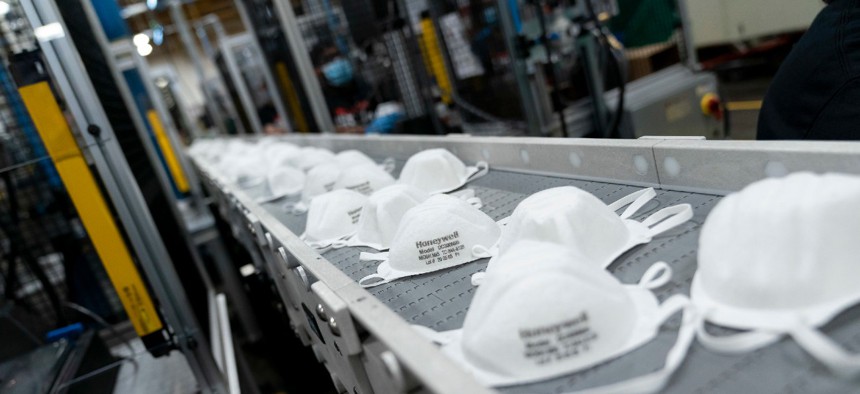
The mask production assembly line on May 5 at Honeywell International Inc. in Phoenix. Official White House Photo by Shealah Craighead
We Have the Manufacturing Might to Fight COVID-19
What we lack is a national plan and coordination.
Americans are still feeling the pain of critical supply shortages. We have the technology to make what we need, but the country’s manufacturing sector is poorly organized to respond to a crisis.
Two things have gone wrong.
First, production of much of the critical equipment we need to respond to emergencies has been outsourced abroad in the name of cost-cutting. The few domestic producers of N95 masks, for instance, are operating at capacity, leaving us dependent on overseas manufacturers and middlemen who have ratcheted up prices.
Second, no one has stepped into the role of orchestra conductor; we are not convening, coordinating or collaborating. Thus, for the good of the nation, we are calling on Congress to enact legislation that would ensure the manufacturing sector is better coordinated and prepared for the next emergency.
We ask them to consider three ideas:
1. Create a national virtual warehouse to store electronic designs and manufacturing instructions for critical emergency equipment.
Large companies are doing this now for the design and production of their own parts. Such blueprints, available for download only in times of emergency, would reduce the amount of time it takes manufacturers to switch production to the most needed types of equipment, and enable small- and medium-sized manufacturers to jump into parts production.
These blueprints also would come with pre-approved emergency licensing agreements.
At the peak of the pandemic, in partnership with Carbon and others, digital manufacturer Fast Radius produced 300,000 nasal swabs in one month using industrial 3D printers. Until the pandemic, the nation didn’t even have an FDA-certified digitally manufactured swab. Now, if we had a place to put these digital designs, certified manufacturers could call on these blueprints under a licensing agreement that would go into effect when needed.
2. Map the supply chains for this critical equipment and anticipate potential shortages.
For instance, we know that any day now we could have a vaccine. Do we have enough glassmakers for the glass vials? Do we have enough sand, soda ash, limestone, etc. needed to make the glass? Do we have enough syringes? Sterilization pads? Temperature controlled logistics?
Consider the ventilator GM produced with its partner, Ventec Life Systems. It had 700 parts coming from more than 100 suppliers. Turns out, one of those parts was made in India at one factory that was closed because the entire region had been quarantined.
GM executives had to fly to India to get that factory running again. But even the reopening of the factory solved only one problem, because that factory’s raw-material suppliers were closed, too. GM and Ventec had to get the suppliers of their supplier restarted as well — or else not one single ventilator was going to come off that assembly line.
We need to know those vulnerabilities in advance. And that information needs to be stored securely in the cloud in a single manufacturing data exchange.
3. Create a formal network of subject-matter experts in manufacturing that could be called upon in emergencies.
This manufacturing guard (akin to the National Guard) could be composed of employer-nominated personnel trained to share best practices and strengthen the nation’s industrial response to crises.
Just like the National Guard, these members would be compensated for their service. Companies and individuals would receive tax incentives or other compensation for their participation. This force would be coordinated by a federal Resilient Manufacturing Advisory Council and complemented by a similar technology corps.
Senators Marco Rubio, R-Fla.; Christopher Coons, D-N.J.; John Cornyn, R-Texas; Maggie Hassan, D-N.H.; and Representatives Haley Stevens, D-Mich., and Troy Balderson, R-Ohio, have introduced the Resilient Manufacturing Task Force Act of 2020 to create this system. Leaders should get behind it.
To recap, America needs:
- Plans for critical medical equipment stored in a virtual warehouse;
- Supply chains mapped and likely producers pre-identified;
- Intellectual property rights pre-negotiated; and
- A ready and willing workforce.
We stand ready to enlist.
Chandra Brown is the CEO of MxD, the nation’s digital manufacturing institute, and the former deputy assistant secretary of manufacturing at the Commerce Department. Lou Rassey is CEO of Fast Radius, a manufacturing technology company that runs one of the most advanced “Lighthouse” factories in the world.






